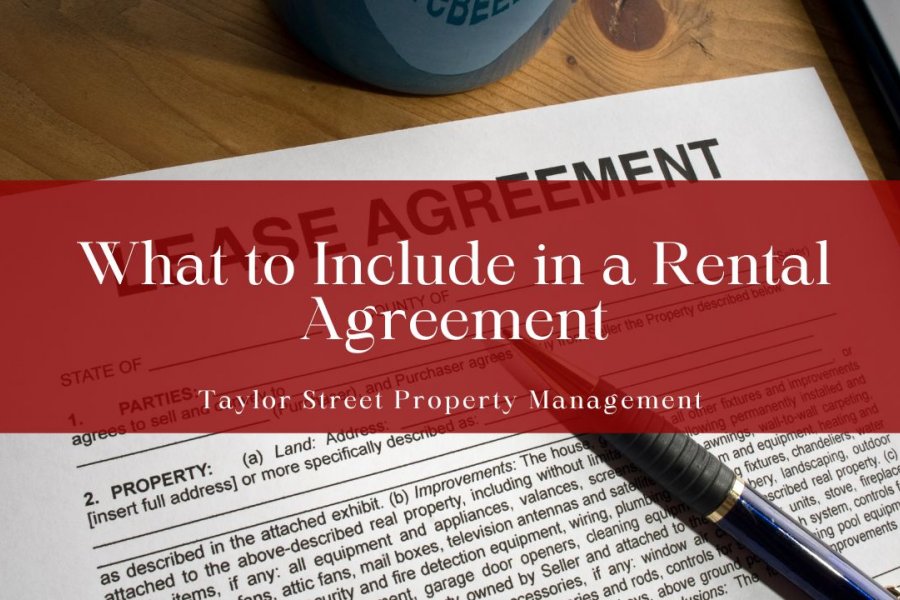
While not required by law, a lease agreement is an immensely practical and important document that you should use in all your rental agreements. You can use this lease to set out any rules you may want your tenant to follow. For example, you can use the lease to let a tenant know about their maintenance responsibilities and set clear expectations for your rent payments.
But at Taylor Street Property Management, we believe that, for your lease to be effective, it must include certain basic information. Which is why we have put together the following article, so you can understand what this basic information is, and how to use it.
The Formal Names of Every Resident
By adding the full formal and legal names of your residents to the agreement, you are binding those specific people to the rules you have laid out. As such, you’ll be able to enforce these terms if any of the specific people cause a violation.

Occupancy Limits
Your lease agreement should also clearly state the occupancy limits. Specifically, it should state that the only people who can live on the property are the people who has signed the lease agreement, plus their children.
This will give you the right to determine the kind of tenant that lives on your rental property. That is, a tenant that you have screened and you know meets your selection criteria.
What’s more, the clause gives you the right to evict anyone else that may occupy the property without your permission. In other words, it’ll help prevent illegal subletting of the unit by your tenant.
Length and Period of the Lease
There are two types of rental documents: a periodic agreement and a fixed-term lease. In a periodic agreement, the tenancy runs either on a weekly, monthly, or quarterly basis. The agreement then renews every cycle until either party terminates it by serving the other party a move out notice.
But a fixed-term lease agreement typically lasts anywhere between 6 months and a year. If operating this type of a lease agreement, make sure to mention the end date. This will help prevent having a holdover tenant after the term has expired.

Provide Detailed Rent Payment Rules
Your lease should provide more details rather than just the rent amount. It should also state the following details:
- The expected due date of the rent.
- The deposit location of the rent (be it physical or digital).
- The payment methods to be used (cash, bank transfer, etc.).
- Any penalties you will apply for late payments.
- Any penalties you will apply for failed payments.
This can help ensure that you are paid rent on time, every month. Especially, if you set the right rental price and provide simple, convenient rent payment options for your tenants.
Deposits or Charges Expected Before the Move-In
Other than rent, another common move-in cost is the security deposit. Requiring a security deposit helps cushion landlords against potential financial damages that may arise as a result of renting out their property.
Just like in other states, Arizona has security deposit laws in place that you must follow if you charge a security deposit. The following are a couple of the rules you must follow:
- You must not demand a security deposit that exceeds one and a half months’ rent.
- You must return the deposit back to the tenant within 14 days.
- You must only make allowable deductions to the tenant’s security deposit. For example, in the event the tenant causes negligent property damage, that is not considered wear and tear, or moves out without clearing their utility bills.
The rules governing the handling of tenants’ security deposits in Arizona are primarily regulated by AZ Rev Stat § 33-1321.
All Repair and Maintenance Responsibilities
Use this clause to clearly set out the responsibilities of each party when it comes to repairs and maintenance. With that in mind, you will need to inform your tenant that they are responsible for the following:
- Keeping fixtures clean and in a sanitary condition.
- Taking care of small repairs and maintenance.
- Not disturbing the peace and quiet of other tenants and neighbors.
- Reporting maintenance issues as soon as the spot them.
- Any restrictions on tenant repairs or alterations.
Please note that you must make requested repairs within 10 days after being notified. If you fail to do this, your tenant may exercise any of their legal rights. Including, withholding future rent payments, making the repairs themselves and then making appropriate deductions, or even suing you for negligence.

When You Can Enter the Property
Your lease agreement should let your tenant know that you reserve the right to enter their rental premises. Be that as it may, to avoid potential harassment claims or complaints, you will need to clarify certain aspects of when and how you will enter:
- The minimum notice you’ll provide them prior to entering. In Arizona, you must provide a tenant a 2 days’ advance notice.
- The reason for entry. You must only enter for legitimate reasons, such as to inspect the unit, or to show the unit to prospective tenants or lenders.
- The entry hours. Mention that you’ll only enter during normal business hours or as agreed.
Bottom Line
These are just a handful of the terms of that a basic lease agreement should include. But these terms will help make your experience as a landlord be more successful as you are minimizing potential confusion or misunderstanding between you and your tenant.
If you need expert help in drafting it, Taylor Street Property Management can help. We’re a reliable property management company in Phoenix, AZ. Get in touch to learn more!

